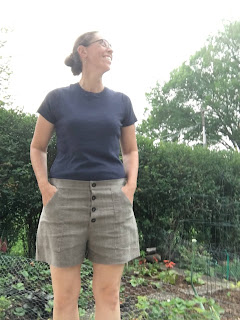This German made Durkopp is my first hand crank sewing machine. The closest approximation for when it was made is 1890's-1910. It has a porcelain handle on the wheel, built-in bobbin winder, and mother of pearl inlay on the base. The machine came to me in May of 2018. A couple was downsizing their collection and hoped that I would take care of this beauty. The machine had been in the family for a couple generations, originating with a relative who was a tailor. It had not been used in quite some time, but the wheel turned partway around and I had high hopes of getting it going again. There was one bobbin in the shuttle and that was it for accessories.
 |
| The machine is beautiful and I would love to learn as much about it as I can |
 |
| The wooden base has some inlay of its own, but it is missing the top |
Took it down to class at Ray's with the hopes of getting some information on how to clean and service the machine correctly. Cathy was helping at class this year and she was so generous with her time and expertise. In the first two days of class while I was working on a couple other machines, Cathy spent a good while getting the machine to turn freely. She removed the glue holding the slide plate closed, replaced the crumbling bobbin tire, and lubricated until the wheel would make a full turn without catching. I was so excited to hear the machine running on the afternoon of the second day.
 |
| The last bits of a bobbin tire |
 |
| After a bit of cleaning |
 |
| Learning how to thread the bobbin winder |
 |
| Needlebar before cleaning |
 |
| Needlebar after cleaning |
On the third day of class, Cathy showed me now to use the bobbin winder, thread the machine, put in the shuttle, crank the machine away from me, and then what the next steps would be for cleaning the rest of the machine. She demonstrated how to access the insides of the machine from different panels, where to lubricate, and pointed out where I would adjust feed dog height if needed.
 |
| Can you see that somewhat heart shaped appendage on the needle bar? |
 |
| Here it is out of the machine and cleaned |
 |
| Bobbin winder |
 |
| Putting bobbin in the shuttle |
 |
| Shuttle into machine |
 |
| Threading the machine |
It takes a round shank 12 X 1 needle, but supposedly a DBX-1 can be substituted. The needle is threaded from front to back.
This machine only does a straight stitch and there is no reverse.
The stitch length knob is behind the bobbin winder at the base of the machine.
Since coming back from Ray's last summer, I had tried sewing with the machine a couple times. In the first session though, I broke the needle that was in the machine. I tried to replace it with some DBX-1 needles that Pat had sent me, but I never could get them to line up with the needle hole. The second time I played around with the machine I never did get the needle inserted and there were no stitches produced.
The first weekend in December, I was in Iowa City hanging out with fellow sewing machine enthusiasts Megan and Pat. The three of us studied the machine and Megan had a whole collection of needles to try out. We realized the needles I had were size 20 and way too big, so we replaced them with some Organ brand size 10 needles. This worked like a charm. Now the machine would sew. There are still some tension issues to be worked out, but that's a project for another day. For now, I have a beautiful, working, hand crank machine.



























































